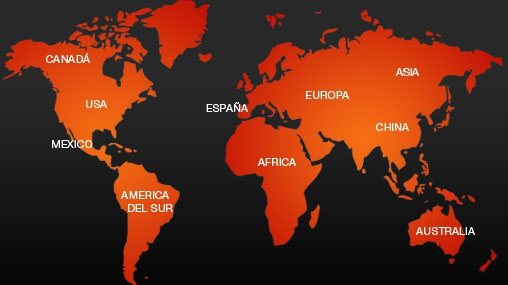- Inicio Acerca de RM Minerales
- Galería de fotos Blog RM Contacto
- Microscopia e instrumentos Pedidos Aviso legal
Copyright 2010-2025
www.rosellminerals.com



Diversos cristales de torbernita de pequeño tamaño pero muy definidos. se disponen sobre una matriz de cuarzo cristalizado. Poco habitual para esta localidad portuguesa.
Cristal de vesuvianita, con caras definidas, biterminado, de color verde a marrón oscuro. Viene etiquetado como procedente la zona de Imilchil. Buen tamaño y estética.
Excelente ejemplar de fluorapofilita-(K) con cristales de muy buen tamaño que muestran las formas del prisma tetragonal, con caras de la bipirámide truncadas por el pinacoide basal. Muy buena transparencia, brillo y definición. Se dispone de forma muy aérea sobre una matriz con estilbita. Con etiqueta manuscrita de Joan Viñals.
Grupo de cristales de granate pertenecientes a la serie almandino-spessartina, habitualmente con predominio del primero. Los análisis indican la presencia de Fe y Mn, con trazas de Mg. Estos ejemplares fueron identificados como piropos (aluminosilicato de magnesio), pero los resultados analíticos no lo indican.
Grupo de cristales de pirita interpenetrados, con un brillo excepcional. Este ejemplar destaca por sui compleja cristalografía, con formas del cubo, con estriados trigifos, y vértices ricos en caras probablemente trapezoédricas. Una pieza para disfrutar de su estudio, de las que me gustan...


Grupo de cristales de pirita cubo-octaédricos formando un agregado muy estético y brillante.


Excelente ejemplar de bournonita de esta clásica mina Kosovar. Diversos cristales de este sulfoantimoniuro de plomo y cobre, se disponen sobre una matriz formadsa por brillantes cristales de pirita, esfalerita y galena. La bournonita presenta unas visibles maclas cíclicas, brillo semimate, con calcopirita. Se encuentran recubiertas de calcita que se elimina mediante procesos químicos.


Muy estético ejemplar de calcita formado por diversos cristales romboédricos aplanados e interpenetrados, casi lenticulares, con las caras muy definidas y estriadas. Entre translúcidos a transparentes, con brillo y sobre una matriz de roca. Presenta una intensa fluorescencia rosa a roja bajo la luz UVOL. Buen tamaño y calidad.
Cristales blancos alargados de brillo nacarado en crecimientos paralelos implantados sobre grupos de cristales de malaquita de brillo sedoso y color muy profundo y uniforme. De un hallazgo ca. 2010 en Bou Beker donde no se había encontrado esta asociación antes.
Excelente ejemplar de fluorita asturiana, de la clásica zona de Berbes, formado por una matriz dolomítica con cristales tabulares en libro de barita, parcialmente recubiertos de cuarzo y cristales de fluorita. La fluorita presenta formas cúbicas muy definidas, con transparencia, brillo y un color violeta morado uniforme. Muy estético espécimen.


Nutrido grupo de pequeños cristales de piromorfita, prismáticos, hexagonales y truncados por caras pinacoidales. Buen color y brillo. Ejemplares de esta mina no son fáciles de conseguir hoy día. El ejemplar se acompaña de la etiqueta manuscrita de Joan Viñals.
Excelente ejemplar foremado por un nutrido grupo de cristales de bismutinita de la Mina Tazna, en Bolivia. Está formado por cristales prismáticos terminados de bismutinita, divergentes y de color gris metalizado. Algunos cristales muestran una pátina metálica de marcasita/pirita. En la parte posterior podemos observar algunos cristales de cuarzo y cristales de bismutinita metálicos, sin marcasita y de color grisáceo. La mina Tazna es una mina histórica de bismuto y tungsteno en los Andes bolivianos que ha producido especímenes notables durante décadas. Las piezas con esta calidad son muy raras en el mercado. Personalmente, como coleccionista "grises", la encuentro excelente.
Grupo de cristales de barita, entre translúcidos y transparentes, incoloros y de buen tamaño destacando uno de ellos. Muestran caras de los prismas ortorrómbicos y del pinacoide. El de mayor tamaño muestra unas aristas biseladas, con una zona contactada con la matriz. Se acompaña de hematites pulverulenta. Se trata de un ejemplar con muchos años.
La fluorita de las minas de Sant Marçal suelen presentarse como agregados de cristales cúbicos, definidos, a veces salpicados o parcialmente recubiertos por cristales de cuarzo. Las tonalidades amarillas a verdosas son las habituales. Los ejemplares con colores violetas a azulados o verdosos (en función del tipo de luz incidente) son mucho menos freqüentes y muy apreciados por los coleccionistas. Estos ejemplares que ofrecemos fueron recogidos a principios de los años 70. En este ejemplar podemos observar cristales con este tono azulado a verdoso, translúcidos y dispuestos sobre una matriz "pegmatítica" oquerosa característica. Se hallan parcialmente recubiertos de pequeños pero brillantes cristales de cuarzo.
Las minas de Sant Marçal (conocidas también como del Matagalls), se hallan en el macizo del Montseny, en la vertiente oriental del pico del Matagalls (1.700m). Los trabajos se encientran entre unos 1.250 a 1.350 m de altitud. Actualmente esta zona pertenece al Parc Natural del Montseny, por lo que la recogida de ejemplares está totalmente prohibida.
La fluorita de las minas de Sant Marçal suelen presentarse como agregados de cristales cúbicos, definidos, a veces salpicados o parcialmente recubiertos por cristales de cuarzo. Las tonalidades amarillas a verdosas son las habituales. Los ejemplares con colores violetas a azulados o verdosos (en función del tipo de luz incidente) son mucho menos freqüentes y muy apreciados por los coleccionistas. Estos ejemplares que ofrecemos fueron recogidos a principios de los años 70. En este ejemplar podemos observar cristales con este tono azulado a verdoso, translúcidos y dispuestos sobre una matriz "pegmatítica" oquerosa característica. Se hallan parcialmente recubiertos de pequeños pero brillantes cristales de cuarzo.
Las minas de Sant Marçal (conocidas también como del Matagalls), se hallan en el macizo del Montseny, en la vertiente oriental del pico del Matagalls (1.700m). Los trabajos se encientran entre unos 1.250 a 1.350 m de altitud. Actualmente esta zona pertenece al Parc Natural del Montseny, por lo que la recogida de ejemplares está totalmente prohibida.
Los ejemplares de anglesita de esta clásica mina marroquí son bastante difíciles de encontrar hoy día. En esta pieza podemos ver numerosos cristales prismáticos apuntados de este sulfato de plomo, muy brillantes, con caras y aristas muy definidas, transparentes y con el color amarillo natural característico de esta especie. Se disponen rellenando cavidades en una matriz de galena.
Ejemplar de buen tamaño formado por una matriz tapizada de cristales de fluorita, con formas cúbicas, incoloros y muy transparentes. Se hallan parcialmente recubiertos de cristales tabulares de barita de color blanco, salpicados de pequeños cristales de pirita alterados y calcopirita algunos de ellos incluidos en las fluorita.
En esta zona minera boliviana andina se realizó hacia 2010-2013 el hallazgo de una bolsada de minerales de plata con antimonio, destacando algunos ejemplares de stephanita, un sulfoantimoniuro de plata. Este ejemplar flotante está formado por un grupo de cristales, con crecimiento paralelo, y que muestran formas del prisma ortorómbico con estriaciones y caras terminales complejas, algunos de ellos son biterminados. Se distingue de la pirargirita por ser totalmente opaco a la luz, mientras que ésta suele dar colores rojos (platas rojas). Un ejemplar excepcioanl que recuerda a las mejores y antiguas stephanitas mexicanas, aunque esta es de la mina de Porco, la mina de plata más antigua y significativa de Bolivia.
Drusa de cristales tabulares lanceolados de barita, translúcidos en el centro y opalinos en las zonas externas, interpenetrados y brillantes. Se disponen sobre una matriz de pequeños cristales de siderita y tapizav cavidades de tipo septaria. Una curiosidad aragonesa.
Drusa de cristales tabulares lanceolados de barita, translúcidos en el centro y opalinos en las zonas externas, interpenetrados y brillantes. Se disponen sobre una matriz de pequeños cristales de siderita y tapizav cavidades de tipo septaria. Una curiosidad aragonesa.
Muy estético ejemplar formado por numerosos agregados de cristales de vanadinita, tildada de arsenical (endlichita). Prismas hexagonales muy definidos, de color beige, salpicados por diminutos pero brillantes y definidos cristales de descloizita-mottramita, de tonos melados oscuros. La descloizita-mottramita forma glóbulos pero también recubre parcialmente cristales de vanadinita, especialmente en las caras pinacoidales y formando medias lunas, una curiosidad. Estos ejemplares de esta mina marroquí no son habituales hoy día.
Cristal de microclina con inclusiones de moscovita. Presenta caras de la macla de baveno. Los cristales de microclina de esta cantera son un clásico de la mineralogía catalana. Actualmente las explotaciones se encuentran abandonadas y se hace difícil encontrar nuevos ejemplares.
Grupo de cristales de magnetita con formas octaédricas y crecimientos polisintéticos en las caras, buen brillo y tamaño. Con cristales de pirita en la parte posterior del ejemplar. Procede de la colección de Lluis Manchion y se adjunta etiqueta manuscrita.
Este ejemplar nos muestra un rico grupo de cristales prismáticos de chorlo, con las caras terminales definidas y el prisma estriado. Intenso color negro y brillo excelente. Se acompañan de albita y cristales de moscovita.
Grupo de cristales de fluorita, muy definidos, entre transparentes y translúcidos y con un color verde amarillento característico de esta mina. Algunos presentan zonación de color. Se acompañan de pequeños cristales y hialinos de cuarzo. Estos ejemplares que ofrecemos fueron recogidos a principios de los años 70.
